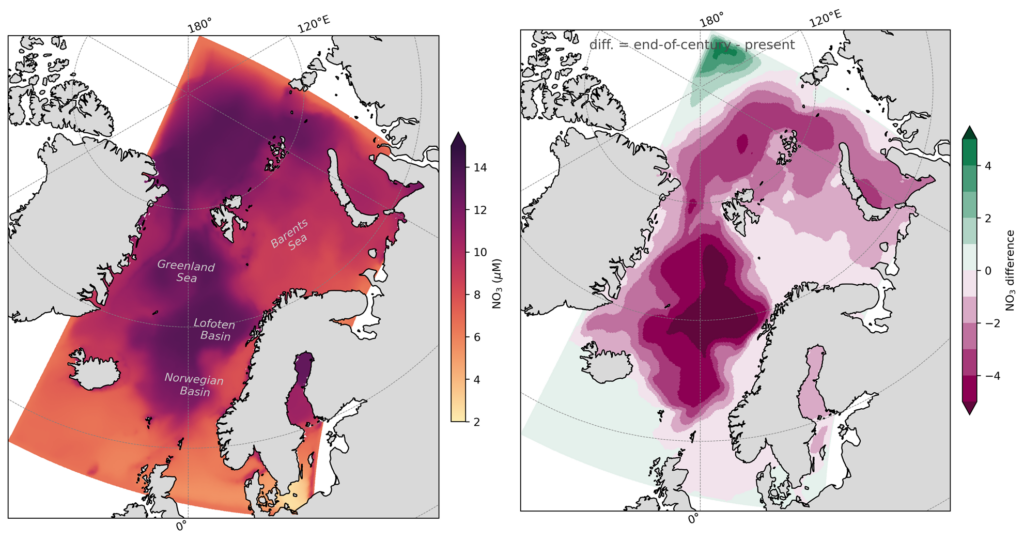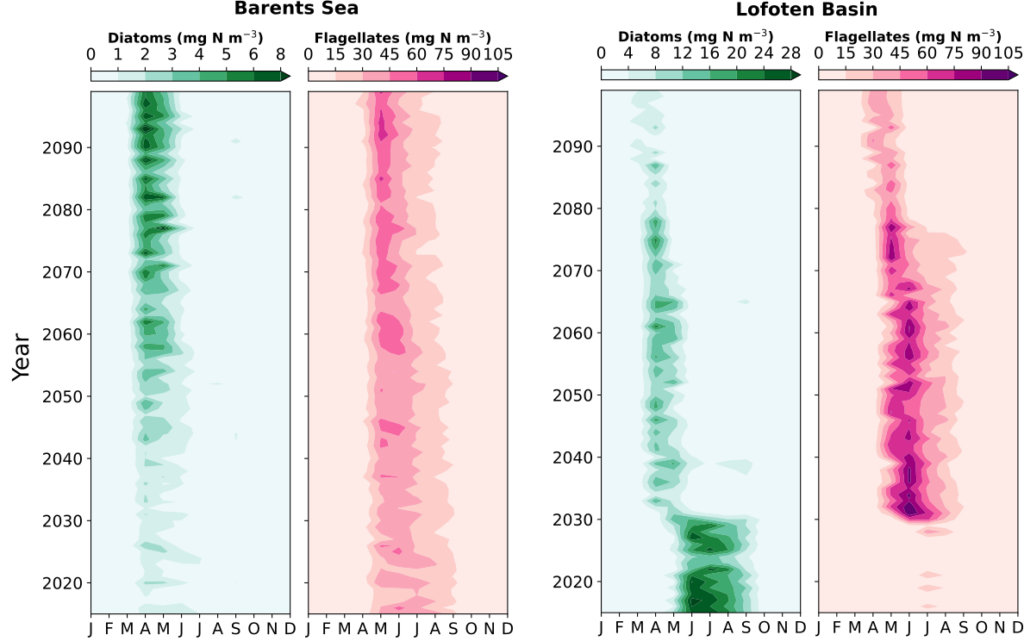Phytoplankton bloom dynamics in the future Arctic Ocean
18 September 2024
We have invited NORCE Post Doc researcher Lucia Gutierrez Loza to write an article on the achievements of PolarRES Work Package 4. WP4 aims to improve our understanding of the key physical and chemical processes in the atmosphere, sea ice and ocean, and the interactions that play a major role in the coupled Arctic climate system and associated Arctic Amplification. In this article, Lucia focuses on the impact of rapidly changing climate conditions in the Arctic on phytoplankton. As global temperatures rise, the phenomenon of Arctic Amplification causes the Arctic to warm faster than the global average, profoundly affecting the Arctic ecosystem.
Atmospheric greenhouse gas concentrations are steadily increasing and, in response, the global
temperatures are getting warmer. In the Arctic, the effects of the changing climate are occurring
more rapidly than anywhere else on Earth, with temperatures increasing up to four times faster than the global average. The consequences are already noticeable in, for example, a substantial sea-ice coverage decline since the beginning of the satellite-based data records in the 70’s, and sea surface temperatures several degrees warmer than the climatological mean values. Changes in the Arctic conditions are expected to continue, and will have major implications, not only for the physical state of the Arctic region, but for the entire ecosystem.
In the ocean, algae and other marine microorganisms consume the carbon dioxide dissolved in seawater to produce organic matter, primarily through photosynthesis, in a similar way that plants and trees do it on land. This process, called primary production, is the base of the ocean’s food chain and is responsible for half of the Earth’s oxygen. Primary production is influenced by environmental conditions such as water temperature, sunlight, and nutrient availability necessary for primary producers, like phytoplankton, to thrive. With warmer seawater temperatures and longer ice-free seasons in several regions, the Arctic has experienced an overall increase in marine primary production. However, the lacking knowledge about the complex interactions between the physical and biogeochemical processes make it difficult to predict whether the increasing pattern will continue under the future Arctic Ocean conditions.
As part of our work in PolarRES, we investigate key physical and biogeochemical processes in the Arctic, and their impact on the future Arctic ecosystem. In this study, we make use of simulations obtained from the regional ecological model NORWECOM.E2E, NORWegian ECOlogical Model system End-To-End. The simulations provide information about the future Arctic conditions for different climate scenarios over the period 2015–2099. Based on these simulations we investigate how physical processes such as vertical mixing and ocean currents, as well as changes in temperature, salinity, and sea ice, modify the environmental conditions affecting the phytoplankton bloom dynamics.
The simulations show an earlier onset of the phytoplankton blooms, resulting in longer productive seasons throughout the century. This response is directly linked to warmer temperatures and longer ice-free seasons, specially in the Barents Sea which is still partially ice-covered during part of the year. However, we found significant regional differences in the response to the future Arctic conditions, with clear differences between the Atlantic sector (Norwegian Basin, Lofoten Basin, and Greenland Sea) and the Arctic sector (Barents Sea). These differences are partly caused by changes in the physical processes which, in turn, result in a modification of the nutrient distribution and availability at the ocean surface. As an example, Fig. 1 shows the current surface nitrate concentrations at the beginning of the simulation period, and their change towards the end of the century.

The Barents Sea, a shallow and well-mixed basin with persistent nutrient supply from the deep ocean to the surface, experiences a smooth intensification of the phytoplankton blooms towards the end of the century (Fig. 2) . This response is consistent with the increasing temperatures and sunlight availability, as well as with an intensification of the vertical mixing. In the Atlantic sector, on the contrary, the simulations show an abrupt change in the phytoplankton dynamics with a sudden shift in the phytoplankton communities, from a diatom-dominated to a flagellate-dominated bloom. This rapid change in the phytoplankton bloom dynamics is noticeable, specially in the Lofoten (shown in the Fig. 2) and Norwegian Basins.

The changes in primary production in the Arctic will have major implications for local and regional ecosystems. However, these impacts will, most probably, not be limited to the Arctic region, as it plays an essential role in the Earth system. Changes in the phytoplankton bloom dynamics have the potential to impact the global carbon cycle, through changes in primary productivity and carbon export into the deep ocean, ultimately affecting the global climate. In order to understand the plausibility, causes, and implication of these changes, more research is necessary.
This article was written by Lucia Gutierrez Loza (NORCE), Early Career Researcher in PolarRES working on marine biogeochemistry in the polar regions. Her main research interests are on air-sea interactions and the carbon cycle.
